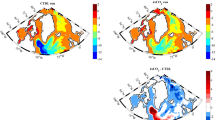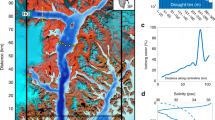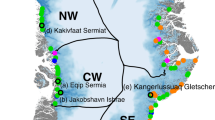Abstract
We investigate the transient response of the global coupled ocean–atmosphere system to enhanced freshwater forcing representative of melting of the Greenland ice sheets. A 50-year long simulation by a coupled atmosphere–ocean general circulation model (CGCM) is compared with another of the same length in which Greenland melting is prescribed. To highlight the importance of coupled atmosphere–ocean processes, the CGCM results are compared with those of two other experiments carried out with the oceanic general circulation model (OGCM). In one of these OGCM experiments, the prescribed surface fluxes of heat, momentum and freshwater correspond to the unperturbed simulation by the CGCM; in the other experiment, Greenland melting is added to the freshwater flux. The responses by the CGCM and OGCM to the Greenland melting have similar patterns in the Atlantic, albeit the former having five times larger amplitudes in sea surface height anomalies. The CGCM shows likewise stronger variability in all state variables in all ocean basins because the impact of Greenland melting is quickly communicated to all ocean basins via atmospheric bridges. We conclude that the response of the global climate to Greenland ice melting is highly dependent on coupled atmosphere–ocean processes. These lead to reduced latent heat flux into the atmosphere and an associated increase in net freshwater flux into the ocean, especially in the subpolar North Atlantic. The combined result is a stronger response of the coupled system to Greenland ice sheet melting.
















Similar content being viewed by others
References
Agarwal N, Köhl A, Stammer D, Mechoso CR (2011) Atmospheric response to high latitude perturbations in oceanic fresh-water forcing (in preparation)
Arakawa A, Schubert WH (1974) Interaction of a cumulus cloud ensemble with the large-scale environment, part I. J Atmos Sci 31:674–701
Cazes-Boezio G, Menemenlis D, Mechoso CR (2008) Impact of ECCO ocean-state estimates on the initialization of seasonal climate forecasts. J Clim 21:1929–1947
Dorman JL, Sellers PJ (1989) A global climatology of albedo, roughness length and stomatal resistance for atmospheric general circulation models as represented by the Simple Biosphere Model (SiB). J Appl Meteorol 28:833–855
Eden C, Greatbatch RJ (2003) A damped decadal oscillation in the North Atlantic climate system. J Clim 16:4043–4060
Gent PR, McWilliams JC (1990) Isopycnal mixing in ocean circulation models. J Phys Oceanogr 20:150–155
Greatbatch RJ (1994) A note on the representation of steric sea-level in models that conserve volume rather than mass. J Geophys Res 99:12767–12771
Harshvardhan RD, Randall DA, Corsetti TG (1987) A fast radiation parameterization for atmospheric circulation models. J Geophys Res 92:1009–1016
Harshvardhan RD, Corsetti TG, Dazlich DA (1989) Earth radiation budget and cloudiness simulations with a general circulation model. J Atmos Sci 46:1922–1942
Hawkins E, Sutton R (2009) Decadal predictability of the Atlantic Ocean in a coupled GCM: forecast skill and optimal perturbations using linear inverse modelling. J Clim. doi:10.1175/2009JCLI2720.1
Hu A, Meehl GA, Han W, Yin J (2009) Transient response of the MOC and climate to potential melting of the Greenland Ice Sheet in the 21st century. Geophys Res Lett. doi:10.1029/2009GL037998
Köhler M (1999) Explicit prediction of ice clouds in general circulation models. Ph.D. dissertation, Department of Atmospheric Sciences, University of California, Los Angeles
Konor CS, Cazes-Boezio G, Mechoso CR, Arakawa A (2008) Parameterization of PBL processes in an atmospheric general circulation model: description and preliminary assessment. Mon Weather Rev 137(3):1061
Large WG, McWilliams JC, Doney S (1994) Oceanic vertical mixing: a review and a model with a nonlocal boundary layer parameterization. Rev Geophys 32:363–403
Landerer FW, JH Jungclaus, L Marotzke (2007) Regional dynamic and steric sea level change in response to the IPCC-A1B scenario. J Phys Oceanogr 37:296–312
Large WG, Danabasoglu G, Doney SC, McWilliams JC (1997) Sensitivity to surface forcing and boundary layer mixing in a global ocean model: annual-mean climatology. J Phys Oceanogr 27:2418–2447
Li JL, Köhler M, Farrara JD, Mechoso CR (2002) The impact of stratocumulus cloud radiative properties on surface heat fluxes simulated with a general circulation model. Mon Weather Rev 130:1433–1441
Luthke S, Zwally H, Abdalati W, Rowlands DD, Ray RD, Nerem RS, Lemoine FG, McCarthy JJ, Chinn DS (2006) Recent Greenland mass loss by drainage system from satellite gravity observations. Science 314(5803):1286–1289
Ma HY, Mechoso CR, Xue Y, Xiao H, Wu CM, Li JL, DeSales F (2010) Impact of land surface processes on the South American warm season climate. Clim Dyn. doi:10.1007/s00382-010-0813-3
Okumora YM, Deser C, Hu A (2009) North Pacific climate response to freshwater focring in the subarctic North Atlantic: oceanic and atmospheric pathways. J Clim. doi:10.1175/2008JCLI2511.1
Pan DM, Randall DA (1998) A cumulus parameterization with a prognostic closure. Q J R Meteorol Soc 124:949–981
Pardaens A, Gregory JM, Lowe J (2010) A model study of factors influencing projected changes in regional sea level over the twenty-first century. Clim Dyn. doi:10.1007/s00382-009-0738-x
Rahmstorf S, Willebrand J (1995) The role of temperature feedback in stabilizing the thermohaline circulation. J Phys Oceanogr 25:787–805
Rahmstorf S, Crucifix M, Ganopolski A, Goosse H, Kamenkovich I, Knutti R, Lohmann G, Marsh R, Mysak LA, Wang Z, Weaver AJ (2005) Thermohaline circulation hysteresis: a model intercomparison. Geophys Res Lett. doi:10.1029/2005GL023655
Redi MH (1982) Oceanic isopycnical mixing by coordinate rotation. J Phys Oceanogr 12:1154–1158
Stammer D (2008) Response of the global ocean to Greenland and Antarctic ice melting. J Geophys Res. doi:10.1029/2006JC004079
Stouffer RJ, Yin J, Gregory JM, Dixon KW, Spelman MJ et al (2006) Investigating the causes of the response of the thermohaline circulation to past and future climate changes. J Clim 19:698–722
Suarez M, Arakawa A, Randall D (1983) The parameterization of the planetary boundary layer in the UCLA general circulation model: formulation and results. Mon Weather Rev 111:2224–2243
Timmermann A, Okumura Y, An SI, Clement A, Dong B, Guilyardi E, Hu A, Jungclaus JH, Renold M, Stocker TF, Stouffer RJ, Sutton R, Xie SP, Yin J (2007) The Influence of a weakening of the Atlantic meridional overturning circulation on ENSO. J Clim. doi:10.1175/JCLI4283.1
Xue Y, Sellers PJ, Kinter JL III, Shukla J (1991) A simplified biosphere model for global climate studies. J Clim 4:345–364
Xue Y, Bastable HG, Dirmeyer PA, Sellers PJ (1996) Sensitivity of simulated surface fluxes to changes in land surface parameterization—a study using ABRACOS data. J Appl Meteorol 35:386–400
Xue Y, Fennessy MJ, Sellers PJ (1996) Impact of vegetation properties on US summer weather prediction. J Geophys Res 101:7419–7430
Acknowledgments
While revising this paper, Peter Herrmann, a co-author of this paper, unexpectedly passed away and we are indebted for his contribution to this paper. We thank R. Ray and S. Luthke for providing the Greenland mass loss field. CRM acknowledges financial support through the Deutsche Forschungs Gemeinschaft (DFG) funded excellence initiative CliSAP during several research visits to the University of Hamburg. We also thank several anonymous referees who provided very constructive and helpful comments. Funded in part through a MPG (Max Planck Society) Fellowship, the Special Research Program (SPP 1257) “Mass transports and distribution in the Earth System” funded by the DFG, and the BMBF (Federal Ministery of Education and Sciencr) Project REAL-GOACE. Contribution to the CliSAP Excellence Cluster, also funded through the DFG.
Author information
Authors and Affiliations
Corresponding author
Rights and permissions
About this article
Cite this article
Stammer, D., Agarwal, N., Herrmann, P. et al. Response of a Coupled Ocean–Atmosphere Model to Greenland Ice Melting. Surv Geophys 32, 621–642 (2011). https://doi.org/10.1007/s10712-011-9142-2
Received:
Accepted:
Published:
Issue Date:
DOI: https://doi.org/10.1007/s10712-011-9142-2




